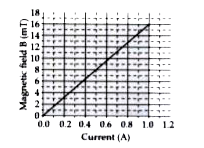Study the given statements and select the correct answer.
(i) Right end of a polysaccharide chain is called reducing end while left end is called non-reducing end.
(ii) Starch can hold cellulose being non-helical, cannot hold iodine.
(iii) Starch and glycogen are branched molecules. (iv) Starch and glycogen are the reserve food materials of plants and animals, respectively.
Statements (i) and (ii) are correct.
Statements (ii) and (iii) are correct.
Only statement (iv) is correct.
All statements are correct.
The correct Answer is:D
Step by step video, text & image solution for Study the given statements and select the correct answer. (i) Right end of a polysaccharide chain is called reducing end while left end is called non-reducing end. (ii) Starch can hold cellulose being non-helical, cannot hold iodine. (iii) Starch and glycogen are branched molecules. (iv) Starch and glycogen are the reserve food materials of plants and animals, respectively. by Biology experts to help you in doubts & scoring excellent marks in Class 11 exams.
Updated on:21/07/2023Topper's Solved these Questions
Similar Questions
True/False
(i) A protein is a homopolymer not a heteropolymer
(ii) RUBISCO is the most abundant protein in the whole biosphere
(iii) Cellulose is a homopolymer ltBrgt (iv) In polysaccharide chain (glycogen) the right end is called non redu cig and
(v) startch has helical structure and its given ionide test
(vi) Cellulose contains a complex helical structure and can hold I2
(vii) Chitin is a heteropolymer
View SolutionRead the following statements and select the correct options.
I. Heart is located in the chest cavity, tilted slightly towards the left.
II. It is composed of cardiac muscle.
III. The left side holds deoxygenated blood and right side holds oxygenated blood.
IV The oxygenated and deoxygenated blood never mix due to presence of a partition wall called septum.
Codes
View Solution
Knowledge Check
I. Right end of polysaccharide is called reducing end while left end is called nonreducing end.
II. Starch can hold la molecules in its helical secondary structure but cellulose being nonhelical, cannot hold
III. Starch and glycogen are branched molecule
IV. Starch in plant and glycogen in animal are store houses of energyAI and IV are correctBII and III are correctCOnly IV is correctDAll are correctStudy the given statements and select the correct answer.
(i) Cellulose is a homospolymer of glucose.
(ii) Inulin is a homopolymer of fructose.
(iii) Starch gives blue colour and glycogen gives red colour with iodine solution.
(iv) Cellulose gives no colour with iodine solution.AStatements (i), (ii) and (iii) are correct.BStatements (i),(ii) and (iv) are correct.CStatements (ii) and (iii) are correct.DAll statements are correct.Go through the following statements.
(i) Lipids are not strictly macromolecules.
(ii) In a polysaccharide , the left end is called the non-reducing chain, the right end called the reducing end.
(iii) Cellulose contains complex helices and hence cannot hold I2.
(iv) Collagen is the most abundant protein most abundant protein in the whole of the biosphere.
Find out the correct statements .A(i), (ii) & (iii)B(i), (iii) & (iv)C(i) ,(ii) &(iv)D(i) & (iv)
Read the following statements and identify the correct ones regarding polysaccharides.
1. Polysaccharides are made of many sugars joined together .
2. Cellulose is a polysaccharide made of less than 10 monomeric units .
3. Polysaccharides are found as a part of the acid insoluble pellet.
4. In a polysaccharide chain, thee right end is called reducing end and the left end is called non-reducing end .
View SolutionWhich Statements about Carbohydrates are CORRECT ?
I. Inulin is a polymer of sucrose .
II. Glucose is a respiratory substrate and is also called fruit sugar .
III. Starch forms helical secondary structures in which it can hold I2 molecules.
IV. The variant of cellulose in animals is glycogen .
View SolutionChoose an option with the correct statements from the list below :
i. The telomere is heterochromatic in nature.
ii. The telocentric chromosome has centromere close to its end.
iii. Satellite is located near primary constriction.
iv. Submetacentric chromosomes are L-shaped.
View SolutionSelect the correct statements regarding the process of transcription in eukaryotes.
(i) The strand of dsDNA which takes part in transcription process is called as coding strand.
(ii) The enzyme RNA polymerase can catalyse polymerisation only in one direction i.e. ,5'→3' .
(iii) An unusual nucleotide methyl guanosine triphosphate is added to the 5' end of hnRNA during capping.
(iv) During tailing process, adenylate residues (200-300) are added at 3' end in a template independent manner.
View SolutionA solenoid is a long helical coil of wire through which a current is runs in order to create a magnetic field. The magnetic field of the solenoid is the superposition of the fields due to the current through each coil. It is nearly uniform inside the solenoid and close to zero outside and is similar to the field of a bar magnet having a north pole at one end and a south pole at the other depending upon the direction of current flow. The magnetic field produced in the solenoid is dependent on a few factors such as, the current in the coil, number of turns per unit length etc.
The following graph is obtained by a researcher while doing an experiment to see the variation of the magnetic field with respect to the current in the solenoid.

The unit of magnetic field as given in the graph attached is in milli-Tesla (mT) and the current is given in Ampere.
After analysing the graph, a student writes the following statements.
I. The magnetic field produced by the solenoid is inversely proportional to the current I
II. The magnetic field produced by the solenoid is directly proportional to the current.
III. The magnetic field produced by the solenoid is directly proportional to square of the current.
IV. The magnetic field produced by the solenoid is independent of the current Choose the correct statement(s).
View Solution
